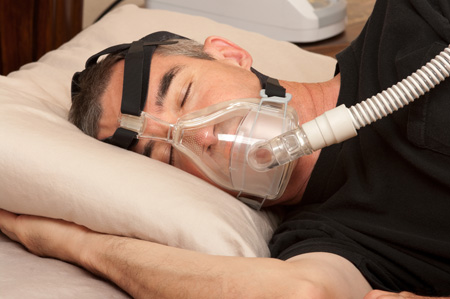Jesús Antonio Hueto-Prado, a researcher in the UPV/EHU's Dermatology, Ophthalmology and ENT Department, has studied people with sleep apnoea syndrome (SAHS) and who are undergoing treatment using CPAP, the treatment regarded as standard for patients with moderate to severe sleep apnoea. It consists of a machine that expels air under pressure and which is delivered to the patient by means of a mask; and it is thus designed to prevent airway collapse, which characterises this condition. Given the fact that tolerating the treatment is a key factor in guaranteeing improvement in the symptoms relating to this disorder, the researcher has studied the factors that could determine the pressure needed in the treatment.
Improving breathing through the nose and losing weight facilitate treatment for sleep apnoea
A UPV/EHU-University of the Basque Country researcher is proposing formulas to predict the treatment needed by patients with severe sleep apnoea
First publication date: 13/04/2015

Sleep apnoea syndrome is the most common among the breathing disorders that occur during sleep. People who suffer from it display interrupted breathing due to the collapse of the upper airways while they are asleep. As a result, there are reductions in the blood oxygen level as well as nocturnal awakenings, which means that the sleep of these people is not refreshing. "This causes these people to feel sleepy during the daytime, and that affects their work performance, increases the risk of falling asleep at the wheel, etc.," explained Hueto. It also has consequences for the circulatory system, "because it encourages hypertension, and even increases the incidence of heart attacks and strokes, among other things," added the researcher.
In the cases of moderate to severe sleep apnoea, the standard treatment applied to patients is CPAP (continuous positive airway pressure). It consists of delivering air under pressure through a mask to prevent the airway collapsing and thus stop breathing from being interrupted. "The air has to be delivered at greater or less pressure, depending on the degree of seriousness of the syndrome," pointed out the researcher.
One of the factors often cited as a potential risk factor for going down with sleep apnoea is nasal resistance which, the greater it is, the more difficult it is for the air to pass through the nose, mainly due to the deviations of the nasal septum, obstructions, chronic rhinitis and other disorders. Taking this a step further, Jesús Antonio Hueto wanted to see whether there was a significant correlation between the level of nasal resistance and the pressure needed in the CPAP treatment as well as between this pressure and other types of anatomical features. For this he studied two groups of patients: some using the CPAP at fairly high pressures, and others using it at fairly low pressures.
Correlation and prediction formulas
The results he obtained in his research confirmed that nasal resistance was significantly greater in patients treated with CPAP at high pressures. "Although nasal obstruction and diminished nasal flow are clear obstacles for treatment using CPAP, until now there have been no studies clarifying this relation," remarked the researcher.
Furthermore, another parameter which he found to have a very significant correlation with the CPAP pressure necessary in the treatment was BMI (body mass index), in other words, the degree of obesity of people. "The BMI is significantly higher in patients requiring high CPAP pressures than in those needing lower pressures."
Apart from corroborating these correlations, Hueto obtained two regression formulas, which are mathematical formulas that allow predictions and extrapolations to be made in a reliable way. In one of them, bearing in mind the BMI value and nasal resistance, the formula allows the CPAP pressure that the person is going to need to be predicted (something which is currently determined by carrying out tests on the patients). He also obtained another formula that provides probabilities of needing one pressure or another depending on the values of resistance that exist and the BMI.
"Since BMI plus nasal resistance play a fundamental role in the formulas obtained, we can assert that the reduction in nasal resistance and weight contribute towards lowering the CPAP pressure needed. The reduction in nasal resistance is achieved by means of surgery in certain cases. The ultimate aim of this research is simply to be able to improve tolerance to the CPAP machine, because patients tolerate lower pressures better and are therefore encouraged not to give up the treatment," concluded Hueto.
Additional information
Jesús Antonio Hueto-Prado is a researcher in the Dermatology, Ophthalmology and ENT Department of the UPV/EHU's Faculty of Medicine and Odontology in Vitoria-Gasteiz, where he did his PhD thesis which is the result of this study. His PhD thesis is entitled Correlational Analysis of nasal resistance and continuous positive airway pressure in treating sleep apnoea syndrome (Análisis correlacional de la resistencia nasal y la presión positiva continua de la vía aérea en el tratamiento del síndrome de apnea del sueño). During the study, he had the collaboration of the Sleep Unit of the University Hospital of Araba in Vitoria-Gasteiz where he had access to the database of patients with sleep apnoea (SAHS) and of those being treated by means of CPAP.

